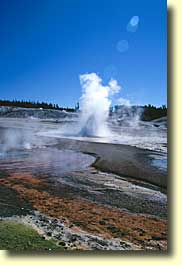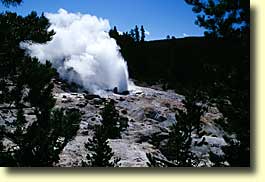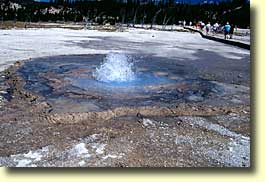Norris Geyser Basin
Russian
Norris Geyser Basin |
Russian |
 |
Thermal features of this area are due to a chamber of hot magma beneath the park which was left behind a gigantic explosion somewhere six hundred thousand years ago. This magma heats the water that percolates down from the surface along fractures and faults. The superheated water rises to the surfaces to form either geysers or hot springs. Geysers from if the plumbing channels contain the construction. The superheated water builds up the pressure beneath the construction until it flashes into the steam pushing the cooler water above up and out as geyser erupts. Hot springs form when there is no plumbing construction and superheated water cools down while reaching surface and gets replaced by hot water from deeper sources. Constant circulation prevents eruptions as it is the case with Mammoth Hot Springs. |
|
"Constant" Geyser |
Due to its whitish color this valley is called Porcelain basin. The color is due to the silicon salts brought to the surface by hot water. As hot water moves towards the surface, the dissolved minerals deposit along subterranean passageways. Eventually these minerals can clog the plumbing and new features (geysers and hot springs) may emerge altering cycles of the neighboring structures. However, mineral deposition is a relatively slow process (approximately an inch in a century) and dramatic changes of the area are not frequent.

The world's tallest active geyser "Steamboat"
|
Beginning of eruption |
During the eruption |
After eruption |
We knew that this geyser has "classic" pattern of eruption: water in its pool is begin to rise and when it reaches the maximum level the geyser erupts. Even though the level was pretty high we have waited for the eruption for approximately 50 min... But the view was worth the wait. One of the interesting features of the geyser is that the acidity of its water is very high (~ pH 3) which is almost as acidic as vinegar. So acidic geysers are rare on Earth and most of them are here in Norris geyser Basin.
Since the ground in the area is very hot and fragile you are allowed to walk only on designated walkways made out of wood or plastic (from recycled plastic containers to be precise). The latter is much less susceptible to deterioration in harsh acidic or alkaline environment however more slippery when wet.

Pearl Geyser - a beauty in the area
[Back to album | Back to photography | Back to front page]
Last updated: Wednesday, June 05, 2002